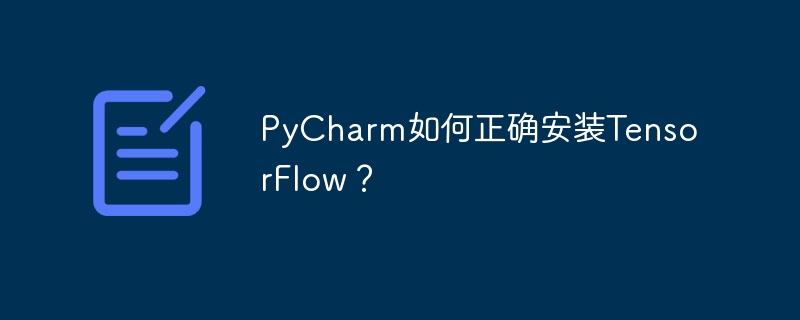

#How to install TensorFlow correctly with PyCharm?
TensorFlow is an open source machine learning framework that is widely used in the fields of deep learning and artificial intelligence. PyCharm is a powerful Python integrated development environment that can help developers program Python more efficiently. In this article, we will introduce how to correctly install TensorFlow in PyCharm to facilitate the development and running of TensorFlow-related projects.
First, make sure you have PyCharm installed. If you haven't installed it yet, you can go to the PyCharm official website to download the version suitable for your operating system and follow the prompts to complete the installation.
In PyCharm, first open the software, and then click the "Create New Project" button to create a new Python project. Choose a suitable project location and select a Python interpreter version (Python 3.x version is recommended).
There are many ways to install TensorFlow in PyCharm. The following is an example of using PyCharm's built-in package management tool pip. Enter the following command in PyCharm's Terminal:
pip install tensorflow
This will automatically download and install the TensorFlow library. If you need to install a specified version of TensorFlow, you can use a command similar to the following:
pip install tensorflow==2.4.1
After completing the installation, you can enter the following code in the Python Console of PyCharm to verify TensorFlow Whether the installation is successful:
import tensorflow as tf print(tf.__version__)
If the version number of TensorFlow is output, it means that TensorFlow has been successfully installed in your PyCharm environment.
Now you can write TensorFlow related codes in PyCharm and run them for experimentation and development. The following is a simple example code for creating a simple neural network model:
import tensorflow as tf
# Define the model
model = tf.keras.Sequential([
tf.keras.layers.Dense(10, activation='relu', input_shape=(784,)),
tf.keras.layers.Dense(10, activation='softmax')
])
# Compile the model
model.compile(optimizer='adam',
loss='sparse_categorical_crossentropy',
metrics=['accuracy'])
# Load datasets and train the model
# [Your dataset loading and training code here]Through the above steps, you have successfully installed TensorFlow in PyCharm and can start using it. It conducts development work related to machine learning and deep learning. I hope this article is helpful to you, and I wish you more results in your learning and application of TensorFlow!
The above is the detailed content of Correct installation steps for TensorFlow and PyCharm configuration. For more information, please follow other related articles on the PHP Chinese website!
 How to change pycharm to Chinese
How to change pycharm to Chinese
 pycharm installation tutorial
pycharm installation tutorial
 How to solve the problem that pycharm cannot find the module
How to solve the problem that pycharm cannot find the module
 How to install pycharm
How to install pycharm
 The difference between python and pycharm
The difference between python and pycharm
 How to configure the pycharm environment
How to configure the pycharm environment
 How to install the pycharm interpreter
How to install the pycharm interpreter
 What does pycharm mean when running in parallel?
What does pycharm mean when running in parallel?




